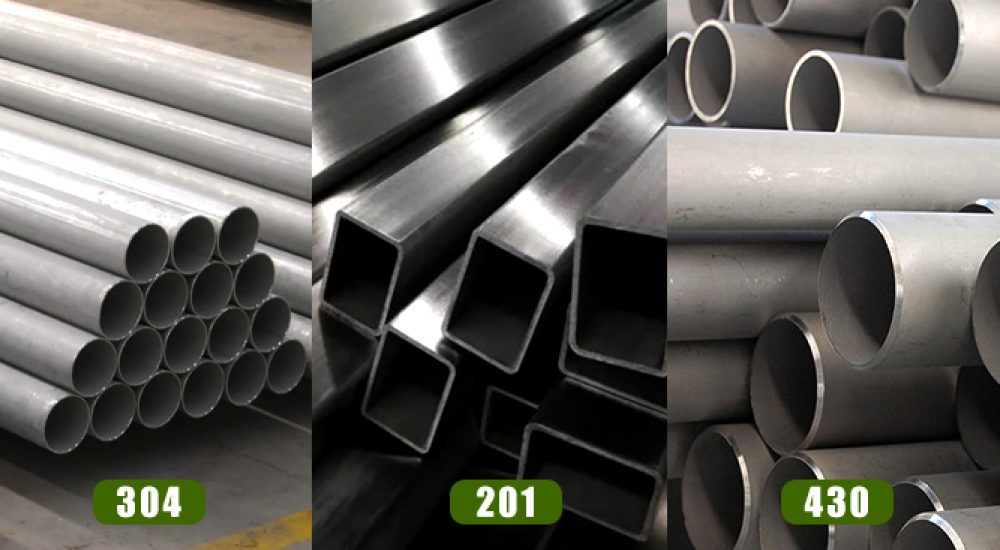
Stainless steel 304, 430, and 201 are very common in life, so what is the difference between these types of stainless steel, let’s take a look at it with me.
Various nicknames for 304 stainless steel
18/8 stainless steel and 8 nickel 18 chromium (generally, the chromium content is not less than 18%, and the nickel content is not less than 8% stainless steel) 18/10 stainless steel (mainly refers to the content of chromium and nickel in the stainless steel within the corresponding range specified by the national standard) sus304 (a 304 stainless steel grade from Japan)
OCr18Ni9 (the new national standard is 06Cr19Ni10, 304 stainless steel pipe and stainless steel plate are also used). 304 stainless steel marking method:
The American Iron and Steel Institute uses three digits to designate various standard grades of malleable stainless steel, including:
①Austenitic stainless steel is marked with numbers of 200 and 300 series, such as some more common austenite stainless steels are marked with 201, 304, 316 and 310;
② Ferritin and martensite stainless steels are represented by 400 series numbers, ferritic stainless steels are marked with 430 and 446, and martensite stainless steels are marked with 410, 420 and 440c;
③Stainless steel, precipitation hardening stainless steel and high alloys with iron content less than 50% are usually named by patent names or trademarks.
The difference between 304 and 201 stainless steel
1. Content of main alloying elements
201 Chemical Composition:
(Cr) Chromium: 13.50~15.0
(Ni) Nickel: 1.02-1.28% (C)
(Mn) Manganese: 5.5~7.50
(C) Carbon: ≤0.15
(SI) Silicon: <0.75
(Cu) copper: half copper u.o70 same size
(P) Phosphorus: ≤0.060
(S) Sulfur: <0.030
201 stainless steel density: 7.93g/cm3
304 Chemical Composition:
(Cr) Chromium: 17.0~19.0
(Ni) Nickel: 8.0~11.0
(Mn) Manganese:≤2.0
(Si) silicon:≤1.0
(C) Carbon: ≤0.15
(P) Phosphorus: ≤0.035
201 stainless steel density: 7.93g/cm3
The density of both is: 7.93g/cm3.
2. Domestic grades
201 stainless steel grade: 1Cr17Mn6Ni5N. 304 stainless steel grade: 06Cr19Ni10 (or OCr18Ni9).
3. Performance
Due to the difference in the content of chromium and nickel and the difference in carbon content, the 304 stainless steel pipe is softer than the 201 stainless steel pipe, and the 304 stainless steel has better corrosion resistance.
4. Scope of application
201 is mainly used in dry areas and decorative areas with lax quality requirements, and 304 stainless steel can be used in bathrooms, kitchens and coastal wet areas.
5. Plating
Vacuum electroplating is better than water electroplating, but both plating methods will first remove the protective film of stainless steel. It is recommended to use 304 stainless steel for electroplating color stainless steel pipes.
How to distinguish stainless steel countertops 304 and 202
The 202 and 304 materials are almost silver-white on the surface, and it is difficult to distinguish from the magnetic surface. The simple identification method is:
1. Use a special potion (actually strong acid) to drip the potion onto the stainless steel surface. After about 1 minute, if the place where the potion is dropped turns red, it means the material is 201; if there is no discoloration, it means the material is 304.
2. Friction spark identification method: You can ask the merchant to order their lower corner material, cut it, and watch the sparks. Generally, 202 stainless steel has more manganese content, so the discounted spark is very stuffy and has more forks, while 304 stainless steel has brighter sparks and fewer forks.
3. If conditions permit, it can be sent to a professional quality inspection department for inspection.
Comparison of 304 and 430 stainless steel
1. Corrosion resistance: 430 stainless steel contains 16.00-18.00% of chromium and basically does not contain nickel metal. 304 stainless steel contains more chromium and nickel metal, so the corrosion resistance of 430 stainless steel is not as good as that of 304 stainless steel.
2. Stability performance: 430 stainless steel is in ferrite form, 304 stainless steel is in austenitic form, 304 stainless steel is more stable than 430 stainless steel.
3. Toughness: 304 stainless steel has strong toughness, which is stronger than that of 430 stainless steel.
4. Thermal conductivity: The ferrite of 430 stainless steel has better thermal conductivity than the austenite of 304 stainless steel.
5. Mechanical properties: 430 stainless steel is added with a stable chemical element titanium, and the mechanical properties of the weld are better than 304 stainless steel.
1. 430 stainless steel is mainly used for building decoration, fuel burner parts, household appliances, and home appliance parts.
2. The steel grade 430F with free cutting performance is added to the 430 steel, which is mainly used for automatic lathes, bolts and nuts, etc.
3. Add Ti or Nb to 430 steel, reduce the C content to 430LX, improve the processing performance and welding performance, mainly used for hot water tanks, hot water supply systems, sanitary appliances, household durable appliances, bicycle flywheels, etc.
304 stainless steel application areas
1. 304 stainless steel has the characteristics of high temperature resistance, good processing performance and high toughness, and is widely used in industry, furniture decoration industry and food and medical industry.
2. 304 stainless steel has strong corrosion resistance and is widely used in the production of equipment and parts that require good comprehensive properties (corrosion resistance and formability).







